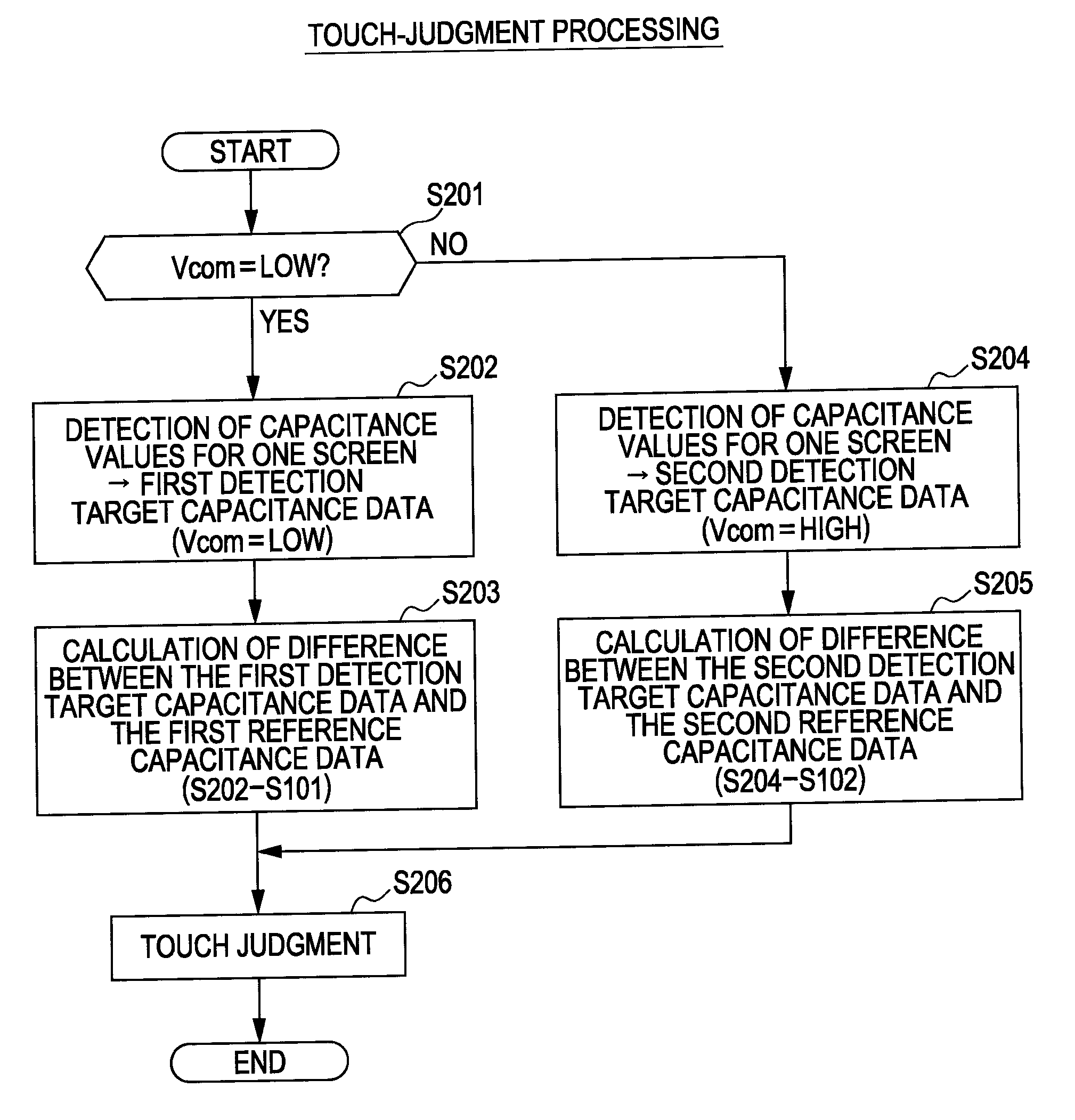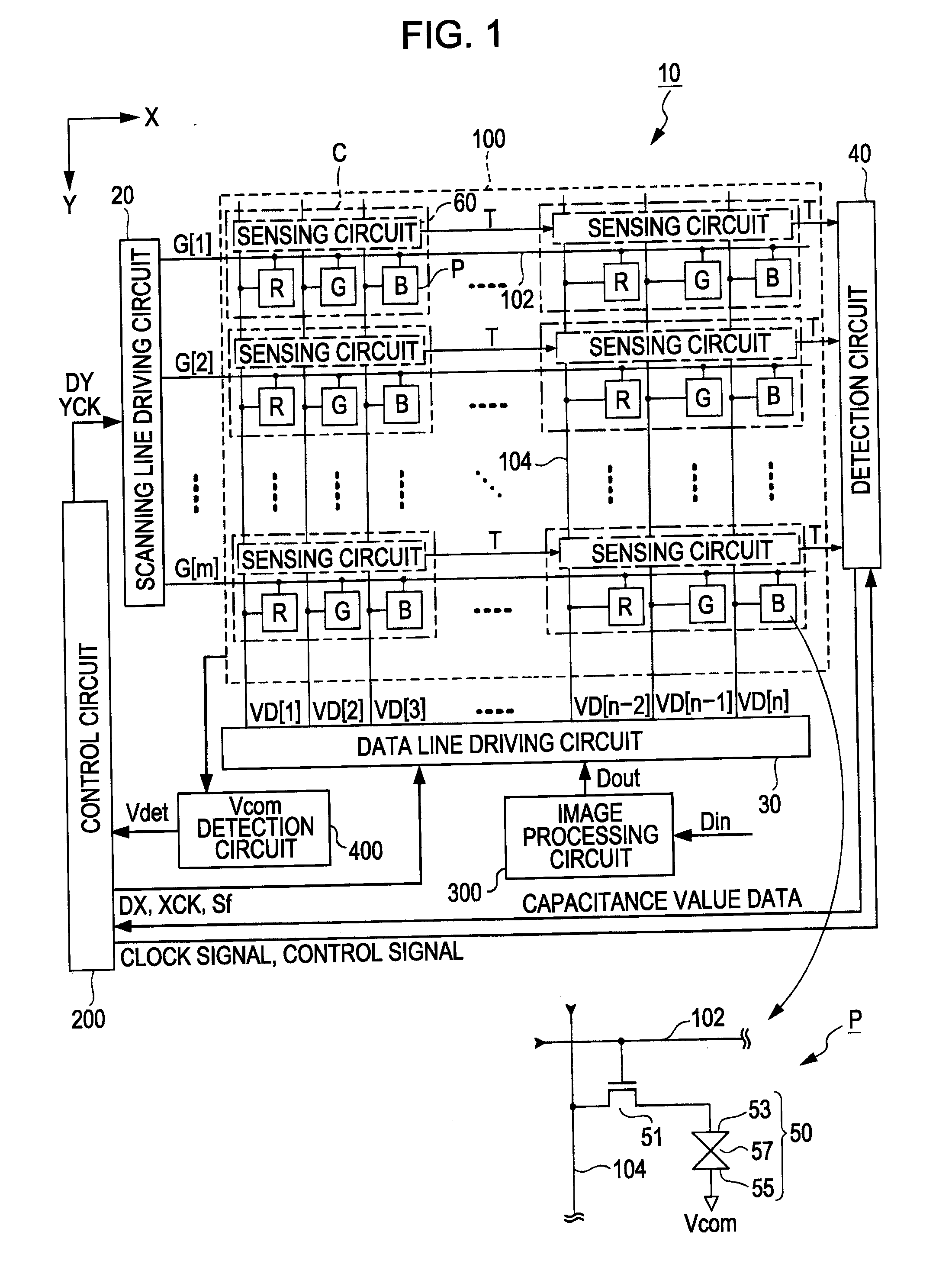Electro-optical device, electronic apparatus, and contact detection method
a technology of optical devices and electronic devices, applied in the direction of instruments, electric digital data processing, computing, etc., can solve problems such as difficulty in obtaining accurate contact judgment, and achieve the effect of high judgment accuracy
- Summary
- Abstract
- Description
- Claims
- Application Information
AI Technical Summary
Benefits of technology
Problems solved by technology
Method used
Image
Examples
first embodiment
A: First Embodiment
[0046]FIG. 1 is a block diagram that schematically illustrates an example of the configuration of an electro-optical device 10 according to a first embodiment of the invention. As illustrated therein, the electro-optical device 10 is provided with a pixel area 100, a scanning line driving circuit 20, a data line driving circuit 30, a detection circuit 40, a control circuit 200, an image processing circuit 300, and a Vcom detection circuit 400. The pixel area 100 has a plurality of lines formed thereon. Specifically, “m” scanning lines 102 are arrayed in parallel with one another in such a manner that each thereof extends in the X direction in the pixel area 100, where “m” is a natural number that is greater than two, or, at the smallest, equal to two. On the other hand, “n” data lines 104 are arrayed in parallel with one another in such a manner that each thereof extends in the Y direction in the pixel area 100, where “n” is also a natural number that is greater t...
second embodiment
B: Second Embodiment
[0084]Next, with reference to FIG. 15, an electro-optical device according to a second embodiment of the invention is explained below. The basic configuration of an electro-optical device according to the present embodiment of the invention is substantially the same as that of the electro-optical device 10 according to the first embodiment of the invention, which is explained above while referring to FIGS. 1-12. Accordingly, in the following description of this specification, the same reference numerals are consistently used for the same components as those described in the first embodiment of the invention. Note that redundant explanation will not be given for the components of an electro-optical device according to the second embodiment of the invention that are the same as those of the electro-optical device 10 according to the first embodiment of the invention.
[0085]Upon the start of initialization processing illustrated in FIG. 15A, the control circuit 200 c...
third embodiment
C: Third Embodiment
[0090]Next, with reference to FIG. 16, an electro-optical device according to a third embodiment of the invention is explained below. The basic configuration of an electro-optical device according to the present embodiment of the invention is substantially the same as that of the electro-optical device 10 according to the first embodiment of the invention, which is explained above while referring to FIGS. 1-12. Accordingly, in the following description of this specification, the same reference numerals are consistently used for the same components as those described in the first embodiment of the invention. Note that redundant explanation will not be given for the components of an electro-optical device according to the third embodiment of the invention that are the same as those of the electro-optical device 10 according to the first embodiment of the invention.
[0091]Upon the start of initialization processing illustrated in FIG. 16A, as a first step thereof, the...
PUM
 Login to View More
Login to View More Abstract
Description
Claims
Application Information
 Login to View More
Login to View More - R&D
- Intellectual Property
- Life Sciences
- Materials
- Tech Scout
- Unparalleled Data Quality
- Higher Quality Content
- 60% Fewer Hallucinations
Browse by: Latest US Patents, China's latest patents, Technical Efficacy Thesaurus, Application Domain, Technology Topic, Popular Technical Reports.
© 2025 PatSnap. All rights reserved.Legal|Privacy policy|Modern Slavery Act Transparency Statement|Sitemap|About US| Contact US: help@patsnap.com



